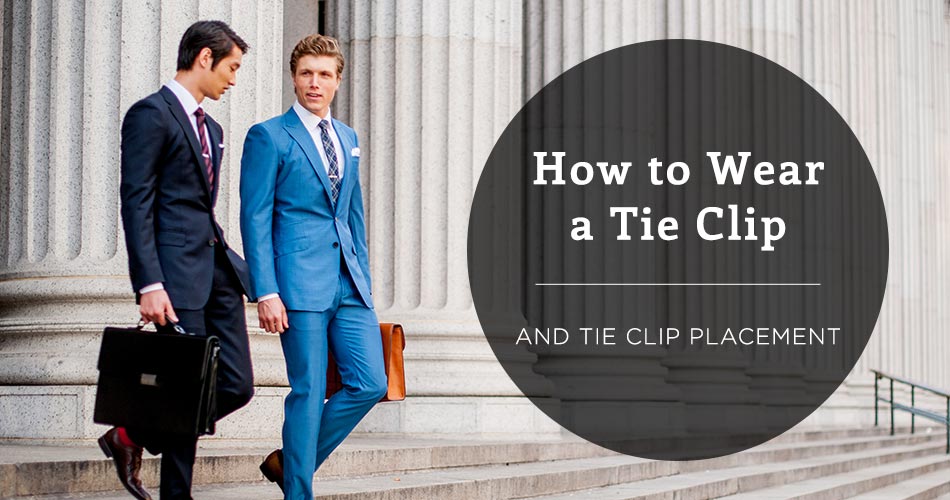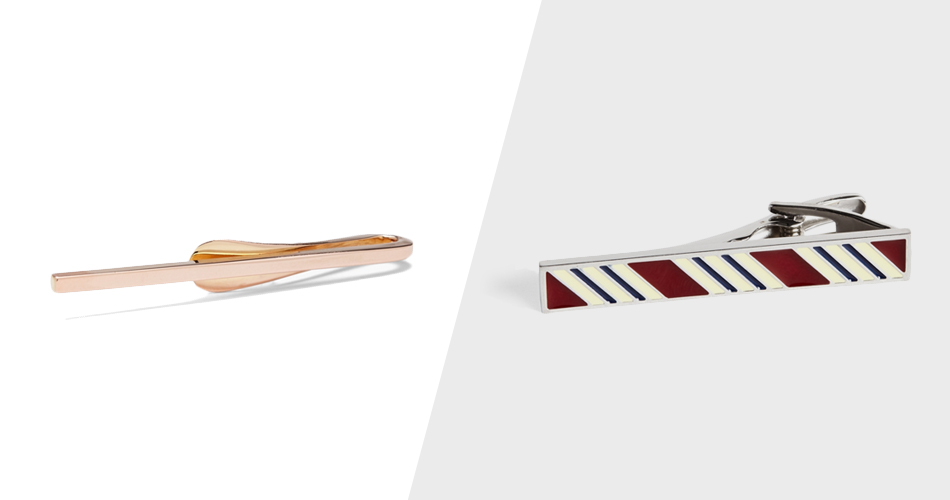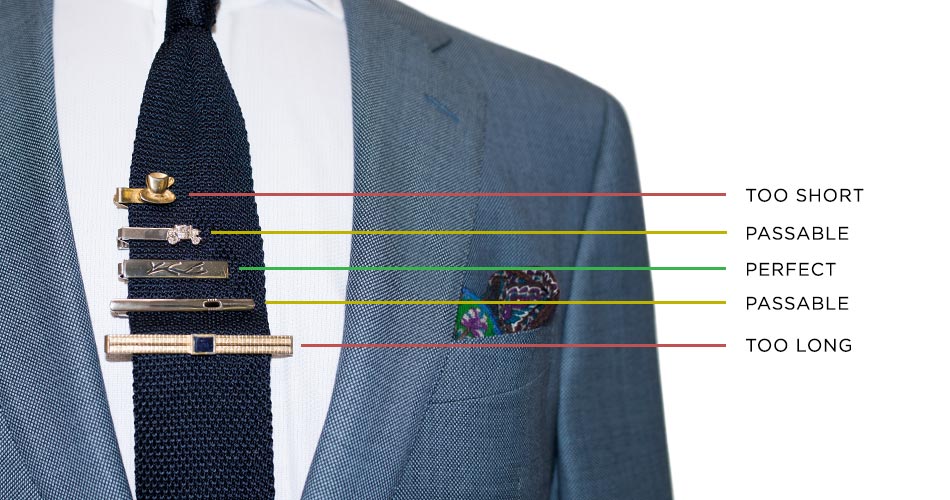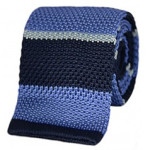How To Wear a Tie Clip — Tie Clip Placement

Learn How to Wear a Tie Clip The Right Way
Editor’s note: this article will reference both tie clips and tie bars — either word can used interchangeably and refer to the same thing.
The tie bar, tie clip, tie clasp, tie-whatever-you-want-to-call-it has established itself as a sartorial staple dating back to well before the 21st-century. Before you learn how to wear a tie clip or what correct tie bar placement looks like, you have to understand tie clips themselves. Functionally, tie clips are quite simply intended to secure your tie to your dress shirt, but they are a product of evolution. Before the early 1900s, ties were still being secured with Victorian Era tie pins. These tie pins served the same purpose as modern tie bars but secured ties to shirts by penetrating through their fabric, resulting in variable degrees of perforations and tie damage.
The location of the pinning also typically took place directly below the knot leaving the tie less secure along its length (vests/waistcoats were also common during this time and they helped secure the rest of the tie). By the 1920s, when higher quality silk ties became more commonplace, the need for a non-penetrative tie fastener led to the eventual birth of the spring loaded tie bar, a design that is still in use alongside the sleek and simple, springless versions (think mini money clip) that are also popular today.
A tie bar is an excellent way to add an extra touch of character to your ensemble while serving a functional purpose as well. Much like learning how to wear cufflinks, when done right, tie clips elevate your style into the next tier of menswear mastery, but much like cufflinks, there are a few things to understand before you move onto tie clip placement.
When Not To Wear a Tie Clip

First, let’s establish when you don’t need to wear a tie clip to avoid unwanted embarrassment. Remember, tie clips serve a function and need to fasten your tie to your shirt placket. You don’t need this fastener when your outfit has fastened it for you, like when you incorporate layers. For example, if you’re wearing a vest or a cardigan, you have a layer above your dress shirt that will naturally hold your tie to your dress shirt, adding a tie bar on top will be overdoing it. When you do sport a vest, however, perhaps that’s an opportunity to don a vintage tie pin you found on eBay.
Choosing Your Tie Clip
As you now know, the tie clip has evolved throughout the years. Much like any evolution process, the final product always has a couple of adaptations. Though the differences are minor, there are still factors in play when you’re choosing between them.
Tie Bar Styles

The first choice is which variation of the tie clip you’re going to wear. There are two choices: slide and pinch clasp.
Pinch clasp (where “tie clip” is derived from) has a toothed hinge and are generally seen as the most secure option for your tie. They’re superior at keeping everything firmly in place, but they’re not always the safest option depending on your tie. Using pinch clasp tie bars with ties made from thin, light materials like knit can result in crimping as the tie clip is bulkier than the intended target. This means the tie clip won’t lay flat against your shirt and thus pinch clasp variations should only be used with thicker, heavier woven ties. Additionally, since pinch clasp uses teeth as part of their functionality which can damage thin, easily penetrated ties.
Slide clasps (“tie bars”) work best with thinner, lighter ties that we see more commonly today. Just the same, slide clasps don’t work as well with thick, heavy ties.
Design

After you choose which tie clip style serves your functional needs, you get to have a little more fun and decide on its aesthetics. There are seemingly no limits to the degree of design that tie clips can incorporate. Some are simply flat and rectangular, some look like car keys with curves, and some are more intricate, designed to look like anchors, fish, guitars, you name it. Whatever you prefer, this comes down to personal choice and what style you’re looking to incorporate.
Color

The early renditions of the tie clip meant you could only choose between silver or gold, but 21st-century wardrobe personality has brought additional tie clip color variations as well. When you’re first starting to build your tie clip collection, we recommend you first cover the basics and add silver and gold first. Silver is subtle and will work with any tie, while gold is essential for your more formal occasions. Once you cover the basics, you have the green light to add some pizazz to your collection; just remember that unlike a silver tie clip, a colorful tie clip may not match every tie you own in your wardrobe.
Tie Clip Size

We generally don’t like rules, but this one’s important: tie bars should never be wider than your tie. This is 101 knowledge, and you probably knew that already, but we’re just covering our bases here. Ideally, your tie clip will end up being around being 50% to 75% the size of your tie, give or take. So remember to vary the tie clip size dependent on the width of your tie, if you’re wearing a skinny tie, you’ll need a smaller tie clip. In the end, just remember that tie clips are not “one size fits all”.
Proper Tie Clip Placement

Now that you’ve chosen your tie clip, you actually need to learn what proper tie bar placement looks like. If you’re into rules of thumb, you’ll generally want to place the tie clip between the third or fourth button on your dress shirt. This should place it correctly in the sternum area just below the pecs and should be roughly around the halfway point between your tie knot and your suit jacket closure button (assuming you’re wearing a standard 2-button suit jacket). Remember, there is a functional purpose to your tie clip, place it low enough to help secure your tie from swinging to and fro, but your tie bar placement should not be so low that it will clash awkwardly with the lines formed when your jacket is closed.
Last but not least when learning how to wear a tie clip is to know to always wear it perpendicular to the tie. This may seem obvious, but there are some who may think an angled look will create visual interest — it won’t. Tie clips should polish and clean your look meaning any angulation will look sloppy and defeat the purpose.
That’s it! Now that you know how to wear a tie clip, and you know what proper tie clip placement looks like, you can step outside 100% confident you’re wearing your accessory the right way.
Have any other questions regarding how to wear tie clips or what correct tie bar placement looks like? Drop it in the comment section below!
Your Next Move:
Like What You See? There's More.
We'll send you style advice and intel for the modern man.




I notice, watching reruns of “Dragnet 1967” or ’69, Joe Friday and Frank Gannon (Harry Morgan) wear their tie clips toward the bottom of their neckties. Was there a time in the 1960s when this was the fashion or was it done sort of Police “style,” like G. I. s wearing their neckties tucked into their shirts?
I notice, watching reruns of “Dragnet 1967” or ’69, Joe Friday and Frank Gannon (Harry Morgan) wear their tie clips toward the bottom of their neckties. Was there a time in the 1960s when this was the fashion or was it done sort of Police “style,” like G. I. s wearing their neckties tucked into their shirts?